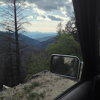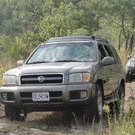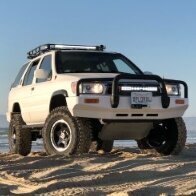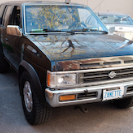Leaderboard
Popular Content
Showing content with the highest reputation since 04/13/2024 in Posts
-
I looked up some part numbers on nissanpartsdeal to see what was up with this. The short version is I don't see why they wouldn't fit. I've heard of people doing dash and interior swaps, and I don't remember anyone complaining that the seat belts didn't bolt up afterwards. If you want to be sure, you could pick up a few grey belt parts from a wrecker or a part-out to confirm that they mount up the same before you shell out for fresh ones. I swapped '95 seat belts into my '93, but they were the same parts, just cleaner (PO was a smoker). For the most part, they're not that tough to work with, but be careful with the belt guide clips halfway up the B pillars. Gotta ease those out gently. And take a picture of the rear belts before taking them out, so you don't mix up the three in the middle. The long version: I looked up the same part (left-hand front belt buckle, color code K) for '87, '90, '93, and '95, and found three part numbers. '87 is 86843-03G60. '90 is 86843-12G60, but the listing suggests that the 12G60 replaces the 03G60, suggesting it's just a minor design change from the original. '95 pulled up 86843-61G00, which for some reason isn't listed as a replacement for 12G60. '93 pulled up 12G60 and 61G00, because transition year, but searching with my VIN pulled up 61G00 only. NPD has an actual photo (for a change!) of 12G60. I compared it to my grey 61G00, and so far as I can compare a low-res picture on a laptop screen to a scuffed-up original IRL and determine which one is which shade of grey, I'm like 90% sure the 12G60 is in fact the brown one. I don't think they changed the part number just for the color, though, because the blue and red buckles also have early and late variants listed for '93. So, yeah, as is often the case with part numbers... something changed around '92/'93. Give it a shot, let us know if it works!1 point
-
Stick your finger on the edge of the valve cover just above the exhaust manifolds. If you feel oil or oily residue then you have your answer. also they are 30 year old trucks now, so if they aren't leaking I'd be surprised.1 point
-
I just want to put out a general Thank You to the new members signing up and/or posting an introduction. We are almost up to 1700 4300 9500 11,600 members (although most are not active) and have new members signing up almost every day with newbie's posting intro's in this section several times a week. Don't be shy !! We have a good community here and like to hear from newcomers. New people and new ideas are what keeps things alive! With input from all around the globe, we get to hear about issues, options and mods that may not be posted if this were just a regional site. Keep in mind though that with world wide members, humor and comments can sometimes be misconstrued, so have patience and be considerate to one another. One of the things that keeps this site so pleasant and friendly is that it is a family oriented site with everyone welcome. Please try to be PC and refrain from overt vulgarities, we are all friends here. Welcome and enjoy !!! Bernard1 point
-
I finally said screw it, let's fix the rust issue. I've got rock sliders in a box, replacement body panels, and a tire carrier sitting around, but I couldn't see myself attaching these all just mere inches from the crusty metal cancer that's been slowly growing over the last 5 years I've owned it. Upon starting the project I had rust holes in the rocker panels that I wish to protect with rock sliders. Lots of crumbly rust around the rear fender flares and a small rust hole in the uniframe in the rear driver wheel well. There was some surface rust and some flakey bits underneath by the spare tire carrier. So I ordered some slip on quarter panels and rocker panels from Nor/Am body parts. First things first, let's attack structural rust so I began by removing the gas tank, fuel filler assembly, evap system, hitch, spare tire carrier assembly, bumper and part of the upper control arm mounting bracket. Next I began opening the hole in the uniframe. Working my way forward... which is downhill, things got better and cleaner so I stopped. Working my way rearward, things stayed crusty. I ended up opening a large section of the uniframe to look inside. It was rusted internally all the way back. That didn't seem to make much sense because you'd figure that the rust problem would be worse in the lower portion of the frame toward the front. Also the exterior of this uniframe rail was in much better shape than inside. Examining the frame rail, I saw the evap system vents into the frame rail. I know for sure that something has always been funky with the evap system because I could smell fresh gas from time to time from the rear of the vehicle despite never having anything be wet or have codes on the dash. I'm assuming the part called a water separator was fouled causing moisture vapor to vent into the frame rail. Ok, so this is gonna be an ordeal to fix. I decide to hit the brakes on that rail and moved to a cross beam that the tire carrier mounts to. I began cutting out the rust to find a fair amount of rust inside this. I stopped cutting when the crusty rust transitioned to mere surface rust. Next the panhard mount on the chassis had some flakey rust so the 'ol hammer test confirms that it's also toast. After releasing the panhard bar I began cutting the lower portion to see how bad it is inside. I lucked out and found that just the lower portion was crusty. This mounting protrustion is connected to a structural cross beam in which, as you guessed, had some crusties. After cutting this open, I find rust at more or less the far ends of this beam where it joins the main frame rails . I'd rather not lop off the entire panhard mounting point, I so I began removing brake lines and fuel lines to clear a path to where I can cut an access hole at the upper most portion of the mounting point. That's more or less where we ended up this week. It's definitely not an exciting project to write about and there's a million other things I'd rather do right now but I figured I'd sort of roll out some updates on this until we get to the finish line. Every time I regretfully walk into the garage, I gotta remind myself my ultimate plan for the vehicle is to keep it forever and keep it in better shape than I originally bought it. The blessings I have working for me right now is the valve covers have always leaked and oil kept most of the rust away from the front as far as I know. Mid section seems ok too. So what's next? More rust cutting, more bracket removing, and possibly divorcing the axle from the body. The axle has a solid amount of rust scale everywhere that would eventually eat the suspension mounting points so that's gonna need some love too. I plant to get to a point where every structural beam is opened up and all crusty sections are cut out with a die grinder or sawzall. After that, everything is getting either the grinder, flap wheel, bore polisher or sandblasted to bare metal. Inevitably there will be trace amounts of rust that would be addressed with phosphoric acid. Apparently this converts Iron Oxide to Iron Phosphate which halts rust progression and becomes a paintable surface. Next step replacement sections of steel will be welded back in. Any female threads that had bolts snap off will be drilled out and re-tapped. Any male studs that broke off in a nut, will be welded back in. After welding and sanding, I'll figure out what rust inhibiting primer to use and apply that. I plan to apply this internally in the rails with a special spray I have. Most likely would finish off the axle and underside with bed liner of some sort. After that, new plastic clips, new extended brake hoses from Taylor, and rubber hoses. Then we can resume with quarter panels, rocker panels and learning how to paint a vehicle. Until next time, peace!1 point
-
The seat belt issue is common. My understanding is that everything before '02 or '03 is lifetime (after is ten years), so the dealer should cover it. Here's the TSB for what they try before replacing the whole belt assembly. Mine ran a little faster after I cleaned out the gunk. An earlier version of the TSB has you slide gauze or cheesecloth in between the belt and the ring and polish the gunk off that way, worth a try if you don't have the right size of wire handy.1 point
-
Here's a quick how-to for replacing the CV axle: TOOLS NEEDED: 1. Jack 2. Jack stand(s) 3. Lug wrench 4. Snap-ring pliers (about $10) 5. 3/8" ratchet/driver 6. 12mm socket or ratcheting box wrench 7. 17mm deep socket 8. Screwdriver or putty knife 9. Vise-grips or large pliers 10. Hammer REMOVAL 1. Jack up truck and place on jackstands under the chassis (not the A-arms). 2. Remove tire 3. Remove hub cap on drive flange. Use a flat screwdriver or putty knife to pry it off as you rotate the hub cap with vise-grips. 4. Using snap-ring pliers, remove the snap ring on the CV axle splines (behind the hub cap you just removed). 5. Using a 12mm ratcheting wrench or socket/driver, remove all 6 bolts holding the inner CV axle to the differential flange. To access each pair of bolts, rotate the brake rotor and then to keep it from rotating while loosening the bolts, stick a screwdriver through the brake caliper and the brake rotor vents. 6. Remove 3 17mm nuts from the ball joint and pry/wiggle the ball joint studs out of the A-arm, then swing the A-arm downward 7. Tap the outer end of the CV axle with a hammer to dislodge it from the drive flange and slide it towards the center of the vehicle through the opening created by swinging the A-arm downwards. 8. If the thrust washer is still attached to the outer shaft of the original CV axle, remove it and install it in the same orientation on the new CV axle. INSTALLATION 1. Slide the CV axle back into the hub through the opening created by the swung-down lower A-arm. 2. Hand-thread the 6 12mm bolts holding the inner CV axle flange to the differential flange. 3. Reinstall ball joint and tighten the 3 17mm nuts 4. Tighten 6 12mm bolts holding CV axle to differential flange, first, one per each pair of three, then tighten the second one of each pair. Don't forget to insert that screwdriver through the rotor vents to keep it from spinning. 5. Reinstall snap ring. You may need to pull axle fully through the hub to fully access to the snap ring channel. 6. Reinstall hub cap. 7. Reinstall tire 8. Remove vehicle from jackstands DONE! NOTE: Alternatively, in lieu of removing the ball joint to provide clearance to pull out the CV axle, you may opt to remove the large bolts holding the A-arm to the subframe. There's one long bolt and nut at the front and two bolts at the rear of the A-arm. I think they're 7/8 or 21mm. I forget. This can be more inconvenient because you'll need to remove the splash guard to do this, and those bigger fasteners might need a 1/2" drive or air wrench to remove. The benefit is that that you don't have to fight the torsional resistance of the A-arm bushings or wrangle the ball joint studs through the A-arm, which can be challenging due to the weight/angle of the strut/knuckle assembly.1 point
-
Aspects of a subframe drop include: -The subframe drop is 4 blocks. You can design it several ways, but honestly its simple. You are just making a rectangular spacer between the bolts and pushing the whole subframe down. Mine are 4" height. -The engine requires 2 blocks the same height as the subframe drop blocks. These are also very simple design. Again just a spacer between bolts, rectangular with no angle. -You also need to lift at the front suspension. However there are no longer struts available, so anything longer than AC coils will lead to severe topping out. So you will need spacers here too. These are NOT straight to keep the geometry right. If you are designing your own lift then you'll need some trial and error to make the angle right. My spacers are 2.5" and the rest of the lift comes from the AC coils. Most people have used 4" spacers plus AC or OME coils to achieve 5-6" total lift. -You need to extend the steering shaft. I think most of us are using a honda U-joint with a spined shaft that matches the R50 shaft for the extension. I do not know if a straight extension would work, but I can confirm that this method does. -The rear lift is much simpler than the front. You can use straight cylindrical blocks, longer coils, or both in combination to achieve the desired lift. I have 3" blocks and AC coils. There may be coils from another vehicle that fit, or you can order custom coils. -You will want longer travel shocks in the rear -You will need new bump stops in the rear and possibly limiting straps -The stock panhard rod will be out of stock specs and force your rear axle towards the driver's side. The setup will work like this, but ideally you should make a drop bracket or a longer rod. Adjustable upper and lower control arms can be considered as well. -You'll need longer brake lines front and rear -You'll want to extend both differential breather tubes -Your rear swaybar will be out of whack. I modified a stillen swaybar with longer links that can be disconnected with a single bolt. The front will still work if you want to keep it. -The front skidplate will no longer work, you'll want a new one. -Ideally you should add lateral bracing of the blocks up front. The SFD is kind of like putting your vehicle on stilts, and actions like laterally winching could twist your subframe. A solid skidplate will help. -You'll need to adjust the routing of your front ABS line to prevent stretch -If you are going with larger than 33" tires you will need to do a lot of trimming even after this lift. Of course you'll want to re-gear as well, especially if you have 4.3's. The front blocks: The rear blocks: The engine spacer: The steering extension: The skid and driver's side front block: Installed: I owe Tyler Morgan thanks for doing all the research and providing me with a Prado prototype. You will run into hiccups with any custom project like this. Installation is a lot more involved than doing a regular suspension swap and you will need multiple jacks and stands. Air tools and an engine hoist would make it easier. However, I had very little experience and did the installation alone with only hand tools.1 point











